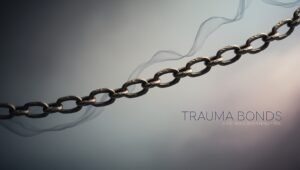Trauma bonding is a complex psychological phenomenon that occurs when a victim develops a strong emotional attachment to their abuser. It’s a twisted bond formed through a cyclical pattern of abuse, tension, and intermittent reinforcement. While it might seem counterintuitive that someone would form a bond with their abuser, it’s essential to understand the psychological mechanisms at play.
Understanding the Cycle of Abuse
To grasp trauma bonding, it’s crucial to recognize the typical cycle of abuse. This cycle generally involves three phases:
- Tension Building: This phase is characterized by increasing tension and hostility in the relationship. The victim may feel on edge, walking on eggshells, or trying to prevent outbursts.
- Acute Abuse: This is the phase where the abuse occurs, whether physical, emotional, psychological, or sexual. It can be a single incident or a series of incidents.
- Honeymoon Phase: Following the abuse, the abuser often displays remorse, affection, and promises to change. This period of calm and affection is what reinforces the trauma bond.
It’s during the honeymoon phase that the victim experiences a sense of relief and hope. The abuser may shower them with gifts, compliments, and promises of a better future. This intermittent reinforcement creates a powerful addiction-like response, making it incredibly difficult for the victim to leave the relationship.
The Psychology of Trauma Bonding
Several psychological factors contribute to trauma bonding:
- Intermittent Reinforcement: The sporadic nature of the abuse and the subsequent periods of kindness create a powerful reinforcement schedule. This is similar to how gambling addictions work, where occasional wins keep people hooked.
- Fear and Intimidation: Abusers often use fear and intimidation to control their victims. This constant fear can make it seem impossible to escape.
- Low Self-Esteem: Victims of abuse often have low self-esteem, leading them to believe they don’t deserve better or that they are responsible for the abuse.
- Isolation: Abusers often isolate their victims from friends and family, limiting their support system and increasing their dependence on the abuser.
Breaking Free from Trauma Bonding
Escaping the clutches of trauma bonding is a challenging but achievable process. It requires courage, support, and professional help. Here are some steps that can assist in breaking free:
- Recognize the Pattern: Understanding the cycle of abuse is the first step. Identifying the patterns of behavior can help you see the relationship for what it truly is.
- Seek Support: Reach out to friends, family, or support groups. Sharing your experiences can provide validation and strength.
- Create a Safety Plan: Develop a plan for leaving the abusive situation. This may involve securing a safe place to stay, financial planning, and legal advice.
- Seek Professional Help: Therapists specializing in trauma can provide guidance, support, and coping strategies.
- Rebuild Self-Esteem: Focus on building self-worth and confidence. This process takes time, but it’s essential for healing.
- Set Boundaries: Establishing healthy boundaries is crucial for preventing future abuse. Learn to say no and prioritize your needs.
- Practice Self-Care: Taking care of your physical and emotional well-being is vital. Engage in activities that bring you joy and relaxation.
Breaking free from trauma bonding is a journey, not a destination. It’s important to be patient with yourself and celebrate small victories along the way. Remember, you deserve a life free from abuse and filled with love and happiness.
Signs of a Traumatic Bond
Trauma bonds often manifest differently depending on the type of relationship, but they typically share two main characteristics: a cyclical nature and a power imbalance.
A Cyclical Nature
Trauma bonds rely on intermittent reinforcement, meaning they thrive on a cycle of abuse. It’s generally easier to leave a situation that is entirely negative, where the abusive person shows no kindness or concern for your well-being. However, in abusive relationships, there are moments when your partner treats you well. They may bring you gifts, call you their soul mate, take you out, or encourage you to relax. This phase is sometimes referred to as “love bombing.”

Over time, these positive moments overshadow the fear of further abuse. As you begin to rebuild trust, you may suppress or ignore memories of past harmful behavior until the cycle inevitably starts again.
A Power Imbalance
These bonds are also rooted in an imbalance of power. You may feel as though the other person controls you so completely that you no longer know how to resist or break free. Even if you manage to leave the relationship, breaking the bond might seem impossible without professional help. You may feel lost or incomplete without them and might return simply because the cycle of abuse is familiar, and you don’t know how to live without it.

Other Key Signs
Here are some additional characteristics of trauma bonds:
- You feel unhappy and may no longer like your partner, but you still feel unable to end the relationship.
- When you try to leave, you experience physical and emotional distress.
- When you express a desire to leave, they promise to change but make no real effort to do so.
- You fixate on the “good” days, using them as proof that they truly care.
- You make excuses for and defend their behavior when others express concern.
- You continue to trust them and hope they will change.
- You protect them by keeping their abusive behavior secret.
Trauma bonds can persist long after the abuse has ended. You might find it difficult to stop thinking about someone who hurt you and feel compelled to reach out or try to reconcile.
Why It Happens
People who haven’t experienced abuse often struggle to understand why others stay in abusive relationships. They might believe you are fully capable of leaving. However, the trauma bond makes it extremely difficult.
People don’t choose abuse, nor can they control the development of trauma bonds, which are driven by powerful biological processes.
The Freeze Response
You might be familiar with the fight-or-flight response, your body’s automatic reaction to a perceived threat. People also respond to threats by freezing or fawning. When you face abuse or fear the possibility of future abuse, your brain recognizes the impending distress and sends a warning to the rest of your body. Stress hormones like adrenaline and cortisol flood in, activating your survival instinct and triggering emotional and physical tension.
When thoughts of the abuse become too painful, you may choose to focus on the positive aspects of the relationship and block out the rest. You might make excuses for the other person and rationalize your need to stay.
Hormones Play a Role
Hormones can strongly reinforce trauma bonds. Apologies, gifts, or physical affection from the abusive person serve as rewards, triggering the release of dopamine, a feel-good hormone. Physical intimacy also prompts the release of oxytocin, further strengthening the bond.
Breaking the Bond
People who experienced abuse in childhood may be drawn to similar relationships in adulthood since their brain recognizes the cycle’s highs and lows. A history of trauma can make breaking trauma bonds even more challenging, but it is possible. Here are some steps that can help:
Know What You’re Dealing With
Recognizing the existence of the bond is an important first step, though it’s often easier said than done.
- Keep a Journal: Writing down daily events can help you identify patterns and recognize behavior that may not have seemed abusive in the moment.
- Seek Perspective: Imagine you’re reading about your relationship in a book. It’s often easier to examine negative events when you can detach yourself from them.
- Talk to Loved Ones: Loved ones can offer valuable perspectives. Challenge yourself to listen and consider their observations.
Avoid Self-Blame
Believing that you caused the abuse or brought it on yourself can make it harder to assert your autonomy, effectively keeping you in the relationship. Remind yourself that abuse is never your fault, regardless of what you may or may not have done, how much you fear loneliness, or how many times you’ve already gone back. You deserve better. Replacing self-criticism and blame with affirmations and positive self-talk can help this truth take hold.
Cut Off Contact Completely
Once you decide to leave, break the cycle entirely by cutting off all communication. If you share children, this might not be possible, but a therapist can help you establish a plan to maintain only necessary contact. Create physical distance by staying with a relative or friend, and consider changing your phone number if possible.
Seek Professional Help
While you can take steps to weaken the trauma bond on your own, these bonds are often difficult to break without professional support, and that’s perfectly normal. A therapist can help you understand the patterns of abuse that drive trauma bonding, providing clarity and insight. In therapy, you can:
- Explore factors fueling the bond
- Work on setting boundaries
- Learn skills for building healthy relationships
- Confront self-criticism and self-blame
- Develop a self-care plan
- Address mental health symptoms related to long-term trauma and abuse
It’s generally recommended to work with a trauma-informed therapist, especially one who specializes in treating post-traumatic stress disorder (PTSD) and the aftereffects of abuse.
Resources for Extra Support
If you need help recognizing abuse, leaving an abusive situation, or beginning the healing process, these resources can provide a starting place:
- Love Is Respect offers resources specifically for people aged 13 to 26.
- The National Domestic Violence Hotline provides free, confidential support 24/7 at 800-799-7233 or via chat. The organization also offers a guide for creating a safety plan.
Frequently Asked Questions
What is a trauma-bonded relationship?
A trauma bond is a deep emotional attachment with someone who causes harm. It often develops from a repeated cycle of abuse and positive reinforcement.
What are the signs of trauma bonding?
Typical signs include denial of the other person’s fault, justification of their actions, increasing isolation from support structures, and increasing dependence on the partner.
What are the 7 stages of trauma bonding?
Trauma bonding can be defined in seven stages:
- Love bombing
- Gaining trust and increasing dependency
- Criticism and devaluation
- Gaslighting
- Submission and resignation
- Loss of self and value
- Emotional dependence
The Bottom Line
Abuse is never your fault, nor is the development of a trauma bond. While it may take time to regain a sense of self-worth and break free, support from a trained professional can make a significant difference.











